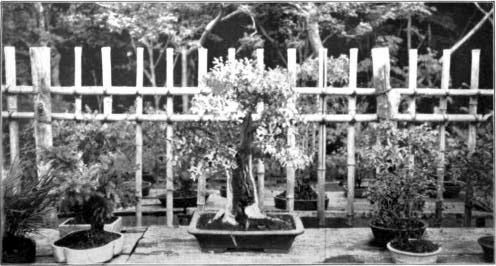|
Around the World Via Siberia
(1902):
"In the Kiukukuji garden at Kioto is a pine tree representing a Japanese junk under full sail, the trunk of the tree is the mast, its branches have been shaped into sails, bowsprit, and rudder. Other trees represent monkeys, birds, umbrellas, etc. The Japanese artist directs the growth of the trunk and branches and the tree does the rest. The Japanese are as kind to the old trees as they are to their aged, infirm, and sick. "[288] The art of dwarfing the giants of the forest is peculiar to Japan. Like so many other things it was borrowed centuries ago from China. It has become a lost art in the country in which it had its origin; it has flourished and has been much improved in Japan. To see a pine or maple tree one hundred and more years old less than two feet in height and show all the outward appearances of great age is something that can only [sic] be seen in Japan. The same can be said of the dwarf pomegranate, quince, olive, pear, and apple trees that blossom and bear fruit in a flower-pot of small size. "The art of inhibiting the growth of all kinds of trees at a certain stage and holding them under the control of the will of the gardener without changing their nature is one that is difficult to explain. Mr. Beumer, the most prominent and successful gardener in Yokohama, explained to me that it depended entirely on the quantity of soil to which the tree is limited. Many of these little old trees live and thrive in their way on a handful of soil in a flower-pot or in the cavity of a rock not larger than a fist. "According to Mr. Beumer, a frequent change of soil is fatal to the tree. The soil should not be changed, that is, the tree should not be transplanted, oftener than once in three or four years. "These Liliputian trees are ornamental in the highest degree, and they can be seen in the small houses and yards of the poor as well as in the mansions and the park-like gardens of the rich. It is said that when these trees are transplanted into the free soil they resume their growth and assert their inherited dignity. It is also stated that many experiments have been made with them in different foreign countries, but invariably without success [sic]. It would be well for our gardeners to inquire into this part of their occupa-  MAPLE TREE IN THE CENTER OVER 100 YEARS OLD "[289] tion and ascertain to what extent dwarfing of trees can be carried in our own country, as such pigmy trees serve as the most attractive ornaments for room, yard, and garden alike." 2 |